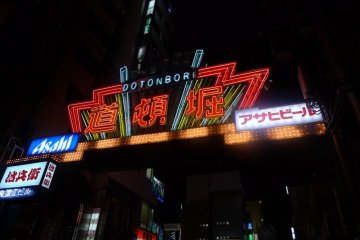
Dotonbori Shopping Arcade
Jeannie GanShop till you drop! Eat till you drop! Dotonbori is the heart and soul of Osaka, a street that never sleeps.

Dotonbori, located along the canal of the same name, is a street in the Namba district of Osaka’s Chuo ward that epitomizes the city’s nightlife. The colorful area is an explosion of neon lights, mouth watering street food, retro vibes, clubs, stores, and bars. A popular saying associated with the street is kuidaore, which roughly means to go bankrupt after spending an enormous amount of money on food. To experience the essence kuidaore (responsibly, of course) be sure to check out this renowned partying spot and lose yourself in the contagious energy!
Roots in the 1600s
The historic street started in the 1620s as a theater district with kabuki and bunraku (puppet) establishments along the canal. Over the years, many theaters closed as people lost interest in the traditional arts, and unfortunately, most of the remaining theaters were destroyed in bombing raids during WWII. Today, Shochiku-za Theater stands as the only reminder of the street’s theater roots.
Today
Today, Dotonbori is one of Osaka’s top tourist destinations. When the sun goes down, flashy neon advertisements light up along the canal and streets. The rainbow of colors illuminates the night air, creating an exciting atmosphere that matches Dotonbori’s offerings. Walk along the bustling street and lose yourself in the tantalizing food smells, energetic chatter, and hypnotizing sights.
Embrace Kuidaore Food Culture
With a phrase like kuidaore associated with the street, there is no doubt that Dotonbori takes its food culture seriously. The street is one of the best places to experience Osaka cuisine, and the area’s flamboyant restaurants themselves are a feast for the eyes. You will need multiple nights to enjoy all of the street’s wonders! For a personalized and unforgettable experience, book a food tour with a local who can guide you through the best spots. Discover Dotonbori's top restaurants.
See the Sights!
After, while, or before you eat, explore the vibrant area. Seemingly every spot of the street is filled with dazzling lights, historic vibes, and unique charm. Listed below are some of Dotonbori’s staple destinations. Though be sure to explore off of the beaten path and discover the street’s many wonders yourself!
The most famous sign in the area is the Glico Running Man, which is located above Ebisubashi Bridge, a popular pedestrian bridge. The giant illumination is an advertisement for the popular Japanese snack company and features a man running on a blue track with his arms raised in victory. The man’s smiling expression matches the exuberance of the street, and his recognizability makes him a focal point and popular photo spot of Dotonbori.
Shochiku-za is the only remaining kabuki establishment from Dotonbori’s theater district days. The theater’s refined facade, with design elements reminiscent of Italian renaissance architecture, contrasts the bright illuminations that define the street. For a traditional Japanese experience, take a break from the street’s party energy and watch a kabuki play at the famous theater.
A unique way to experience Dotonbori is via a river cruise. As you are separated from the packed streets, you can leisurely observe the trademark buildings and watch their lights dance on the shifting waters. A popular cruise service is Tonbori River Cruise, which takes guests on 20-minute water excursions under the street’s nine bridges.
Kuidaore Taro is a mechanical clown statue, with origins in the 1950s, displayed in the lobby of the Nakaza Kuidaore Building. Kuidaore Taro wears a white and red striped outfit and hat with blue accents and round glasses. He welcomes visitors with a cheerful drumming stance and is an icon of Dotonbori street. The building itself contains souvenir shops that sell Japanese snacks, candy, and Kuidaore Taro merchandise.
Hozenji Yokocho is an old-fashioned alleyway beside Dotonbori. The tranquil street is known for its traditional shops and restaurants, soft lantern light, and cobblestone streets. The quieter and slower-paced street is a perfect area to visit if you need a break from the high energy of Dotonbori. At the end of the alleyway is Hozenji Temple.
Dotonbori extends between Daikokubashi and Nippombashi bridges and is about a 5-minute walk from Namba Station.

Shop till you drop! Eat till you drop! Dotonbori is the heart and soul of Osaka, a street that never sleeps.
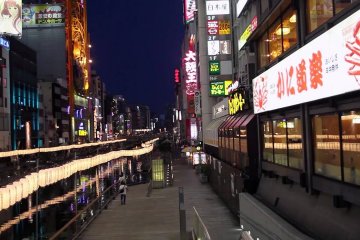
Dōtonbori is one of the must-sees in Osaka. Although the space is wonderful during the day it is truly a sight at night with the flow of people and the illumination of the walkways it is truly a place to see when in Osaka.

Day or night, rain or shine, Shinsaibashi-suji is a perfect destination for anyone traveling Osaka. It's a gregarious atmosphere packed with restaurants and food stands, boasting Osaka’s lively and delicious food culture...
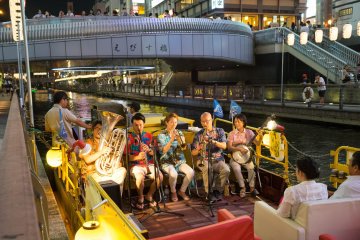
Dotonbori is one of Osaka’s most popular destinations, with hundreds of neon lights and huge billboards advertising different stores. It runs parallel with Dotonbori canal and is a popular food, shopping and entertainment destination. This is also next to Osaka's red district as you will notice people offering services both to locals and tourists. As you walk around the many eateries in the area, try some takoyaki or octopus balls, a very popular dish in Osaka.

The Dotonbori Bridge is great place to enjoy Osaka's outdoor street theater. While the Kabuki playhouses from the 17 th century are long gone, this is a popular meeting spot.
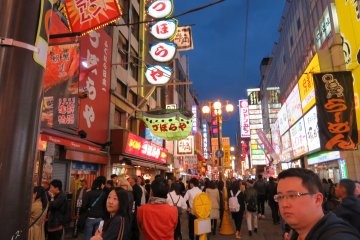
Osaka is known as a city of canals and waterways. Why not enjoy stunning views of Dotonbori from this retro ryokan housed in a waterfront building close to Nipponbashi subway station.
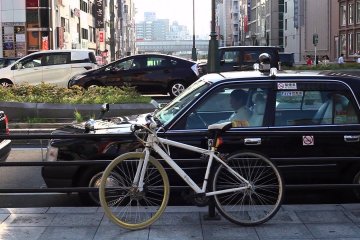
Dotonbori is one of the most popular tourist destinations in Osaka and it is located in the district of Nanba, running along the Dotonbori canal from Dotonboribashi Bridge to Nipponbashi Bridge. The area is always busy but especially at night, when the chaos combined with the shiny neon lights make it the place to be. Absolutely incredible.
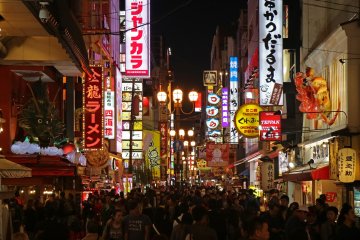


A saying associated with Dotonbori is kuidaore, which means to go bankrupt after spending a large amount of money on food. Not surprisingly, the street is one of the best places to experience Osaka cuisine. Eat on the go as you explore or sit down at one of its restaurants.
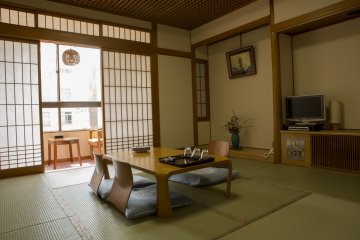
The 60’s are now in the oh-so distant past but the essence of this magic era still remains. Surrounded by the modern neon glow of Soemon-cho, Kaneyoshi Ryokan hotel continues this time warp.

HOTEL MYSTAYS Shinsaibashi makes for an excellent accomodation for tourists visiting Osaka. Combining chic, comfort and convenience, you should definitely consider this hotel on your next trip to this amazing city.
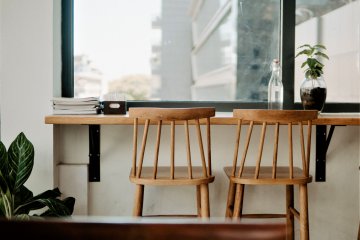
Clean, comfortable beds, elegant décor, close to public transport, helpful staff - The Fraser Residence has them all in spades.
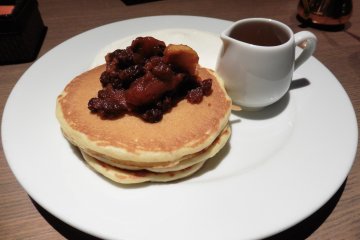
Any better way to spend a lazy afternoon than eating a delicious pancake on a fluffy couch in a fancy looking cafe in Osaka?
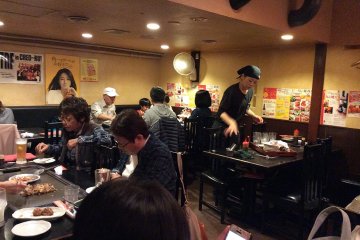
Creo-Ru means creation, where you can create your own okonomiyaki with any ingredient. Since opening in February 1999, they have been operating based on the philosophy of creating happiness with food.
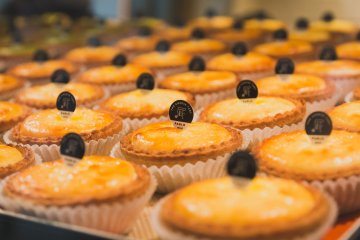
Most delicious cheese tart in Japan now comes in miniature form! Head on down to Akihabara and get your Pablo Mini cheese tarts!
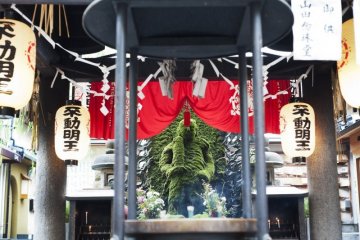
Among the hustle and bustle of Osaka’s renowned shopping and foodie street, Dotonbori, lies a cobblestone alleyway, Hozenji Yokocho, that leads visitors into old Japan. On the far western end of the alley stands the small, yet locally cherished Hozenji Temple. This Buddhist temple, built in 1637, is dedicated to Fudo Myoo, one of the five wisdom kings. During the 17th century, the temple played host to rakugo storytelling and stage performances in the up-and-coming entertainment district. What Hozenji lacks in space, it makes up for in ambience. Follow cobblestone streets past traditional storefronts to reach the modest temple. If you visit during the early morning, evening, or night, your journey will be bathed in the warm glow of lantern light. Once you reach Hozenji, pass under the entrance into the covered area and approach the principal object of worship, the Fudo Myoo statue, which has a bowl and ladle in front of it. It is customary to ladle water onto the statue when you pray for good luck, thus earning the statue the nickname Mizukake (water-throwing) Fudo. Due to years of prayer, the statue has become perpetually covered in moss, giving it a mystical aura. After praying to Fudo Myoo, enjoy the culture of the area by exploring Hozenji Yokocho’s okonomiyaki shops, izakayas, and multitude of restaurants. For a more high-energy experience, take a short walk to flashy Dotonbori and fill your night with street food, bar hopping, neon lights, and more.

Kuromon Market, or Kuromon Ichiba, is a staple destination among tourists and residents alike thanks to its abundance of fresh fish, meat, fruits, vegetables, sweets, clothes, and household/ miscellaneous items. The over 170-year old shopping street extends 580-meters long and is home to approximately 150 shops. Peruse large, commercialized shops alongside mom-and-pop spots and immerse yourself in the preserved food culture of Osaka. The lively atmosphere of shoppers, street food vendors, and tantalizing aromas will make for an unforgettable shopping experience. The historic market, officially established in 1902 with the name Enmyoji Ichiba, quickly gained the nickname Kuromon Ichiba, which translates to Black Gate Market, due to the nearby Enmyoji Temple’s renowned black-painted gate. Although the temple was completely destroyed by fire in the early 20th century, the market’s name still persists today. Although Kuromon Market has become a popular tourist destination, it still retains an authentic feel thanks to its local shoppers, cultural offerings, and down-to-earth vibes. The street is full of exciting finds, so be sure to explore them all! Pick up some preserved and pickled vegetables, wasabi root, bamboo shoots, wagyu beef, fugu (blowfish), strawberry daifuku (mochi covered strawberries), anime merchandise, or second-hand kimonos, to name a few. Given that you are surrounded by food, why not try some as well? Thankfully, the market is a hotspot for street food and quick bites on the go. Try some takoyaki, grilled scallops, sushi, oden (assortment of meat skewers, meatballs, fishcake, and daikon radish in a light soy-flavored dashi broth), kushisei (deep-fried meat skewers), okonomiyaki, fresh fruit juice, and so much more. Make sure you come to the market hungry and enjoy Osaka’s cuisine! As you explore the market please be mindful of your trash and support the cleanliness of the area. Towards the southern end of the market is the Kuromon Information Center. The center is a wonderful place to unwind after hours of walking and offers a seating area, toilets, a diaper changing table, a baggage counter, a currency exchange machine, and Chinese- and English-speaking staff onsite.
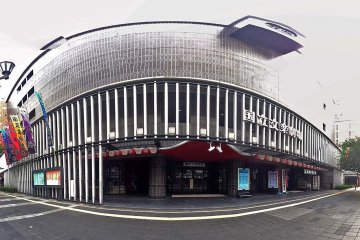
Osaka has been the capital of Bunraku, the traditional Japanese puppet theater, for many centuries. The National Bunraku Theater is a two-hall and exhibition room complex located in Chūō-ku, Osaka. The theater is now one of the few places where where the fascinating art form of bunraku can be seen. The complex opened in 1984 as the country's fourth national theater and became the headquarters of the Bunraku. The National Theater is operated by the Japanese Arts Council, an independent administrative body of the Ministry of Education, Culture, Sports, Science and Technology. English programs and headphones are available. The performances usually take place at three-week intervals in January, April, June, July / August and November.